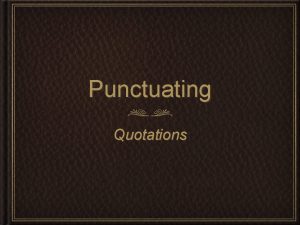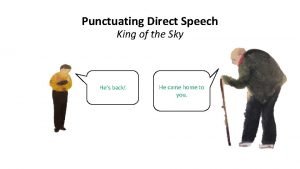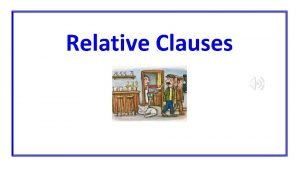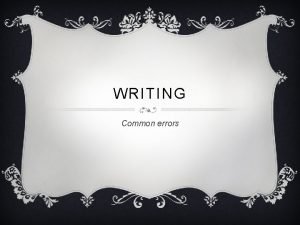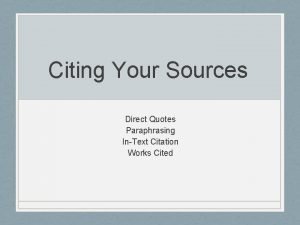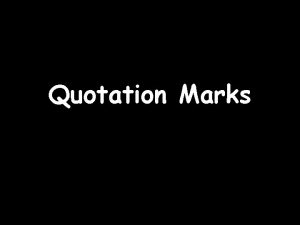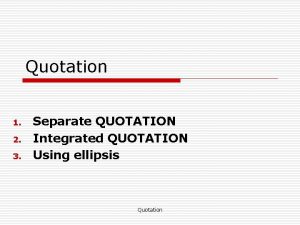Quotations Punctuating Direct Quotations A direct quotation represents









- Slides: 9

Quotations

Punctuating Direct Quotations • A direct quotation represents a person’s exact speech or thoughts and is enclosed in quotation marks (“ “). • Direct Quotation: “I can make a stream carriage that will run 15 miles an hour on good, level railways. ” - Oliver Evans. • Sometimes, you will insert only a quoted phrase into a sentence. You must set this fragment off with quotation marks also. • In the early years of the locomotive, people often called it “the iron horse. ” • “The iron horse” is what people often called the locomotive in its early years.

Indirect Quotations • An indirect quotation reports only the general meaning of what a person said or thought and does not require quotation marks. • Oliver Evans, who had built a steam-powered scow with wheels in 1804, said that he could build a locomotive that could run 15 miles an hour on level track.

Introductory Expression • Use a comma or colon after an introductory expression. • Introductory Expression- A representative of the Smithsonian Institution wrote, “Railroad is one of the most important means of transportation. ” • If you do not use a “he said/she said” expression in your introduction to a quotation or if the introductory phrase takes a more formal tone, use a colon instead of a comma before the quotation. • Example- Walter Larson, mayor of Washington, Missouri, spoke with the reporter: “We are looking forward to the renovated station spurring additional visitors to our community. ” • Use a comma, a question mark, or an exclamation mark after a quotation followed by a concluding expression. • Concluding Expression- “Railroad is one of the most important means of transportation, ” wrote a representative of the Smithsonian Institution. • Use a comma after part of a quoted sentence followed by an interrupting expression. Use another comma after the expression. • Interrupting Expression- “Railroad, ” wrote a representative of the Smithsonian Institution, “is one of the most important means of transportation. ” • Use a comma, a question mark, or an exclamation mark after a quoted sentence that comes before an interrupting expression. Use a period after the expression. • Example: “Should we expect a train any time soon? ” he asked. “It was an hour late yesterday. ”

Other Punctuation with Quotation Marks • Always place a comma or a period inside the final quotation marks. • “You exhibited greater skill in today’s lesson, ” the driving instructor announced. • Always place a semicolon or colon outside the final quotation marks. • His history book reports, “John Stevens built the first steam locomotive in the United States”; however, it had many flaws. • Place a question mark or exclamation mark inside the final quotation mark if the end mark is part of the quotation. • Horatio Allen asked in a letter, “When was the exact date of the first locomotive trip in the United States? ” • Place a question mark or exclamation mark outside the final quotation mark if the end mark is not part of the quotation. • Did you hear that speaker say, “We must reduce energy consumption”?

Quotation Marks in Special Situations • When writing dialogue, begin a new paragraph with each change of speaker. • For quotations longer than a paragraph (4 lines of writing) put quotation marks at the beginning of each paragraph and at the end of the final paragraph. • Use single quotation marks for a quotation within a quotation.

Quotations in Dialogue The station attendant shouted from behind the hood, “You’re a quarter low on oil, Mrs. Lowell. Would you like me to put some in for you? ” “Yes, thank you, ” she replied. “What kind of oil do you use in the car? ” She hesitated and then replied, “I believe the car takes multigrade. ”

Long Quotations “In July of 1831, the West Point Foundry Works of New York first put a steam vehicle on the road. They called it the De Witt Clinton, and to many it seemed like a steam locomotive without tracks. “This De Witt Clinton was not a lightweight vehicle. It weighed about six tons, and its wheels were about five feet across. “Two names associated with this project were John B. Jervis, the man who contracted for the vehicle to be built, and another man, known as Sir Matthew, who served as chief engineer of the project. ”

Single Quotations: • The fund-raiser concluded, saying, “As we try to raise money for this worthy cause, let us not forget that old English proverb that says, ‘Where there’s a will there’s a way. ’”
